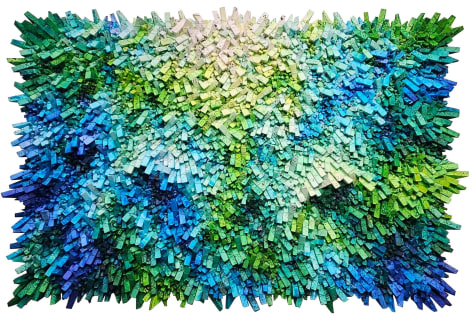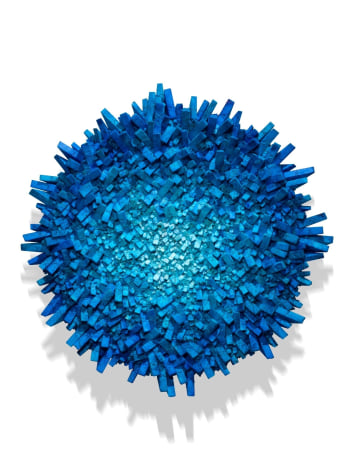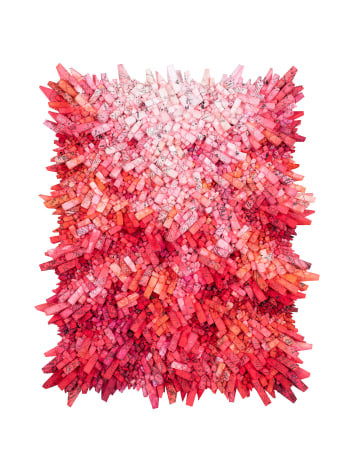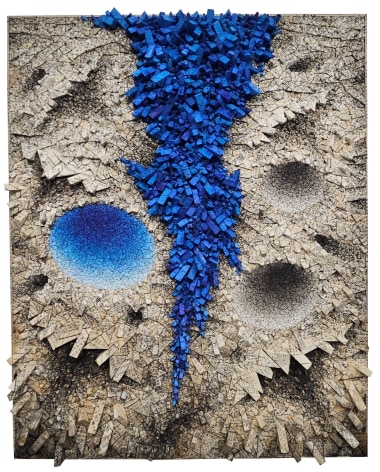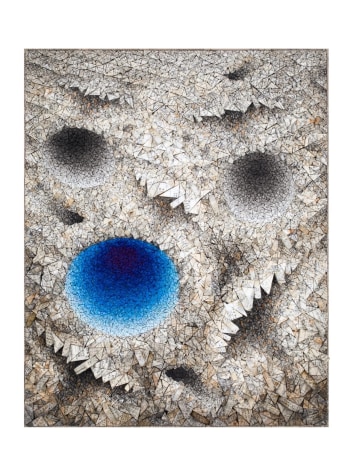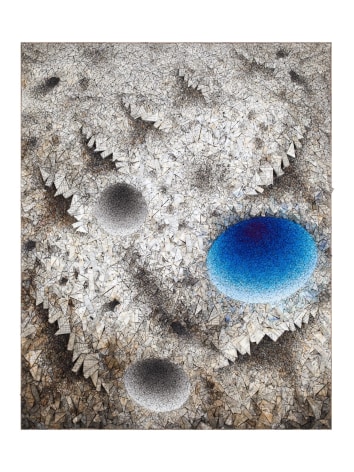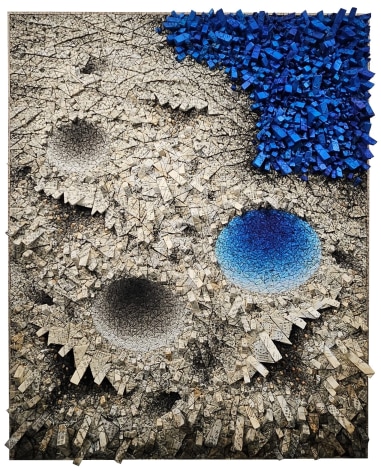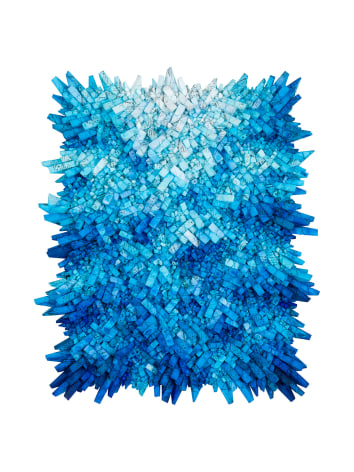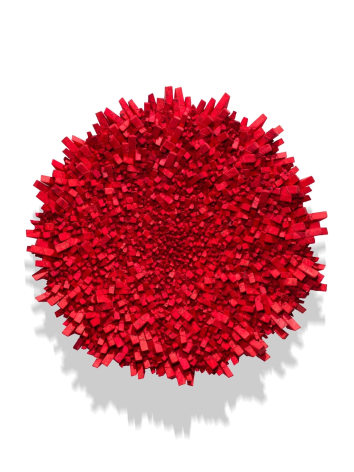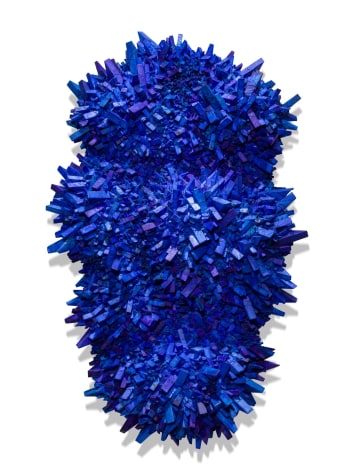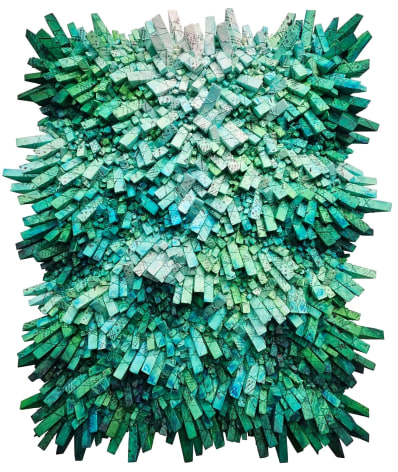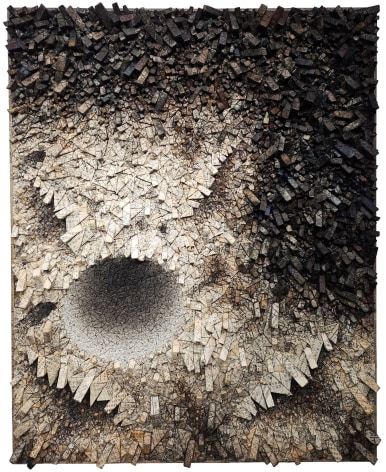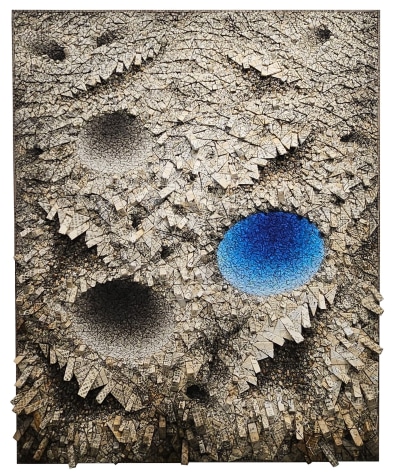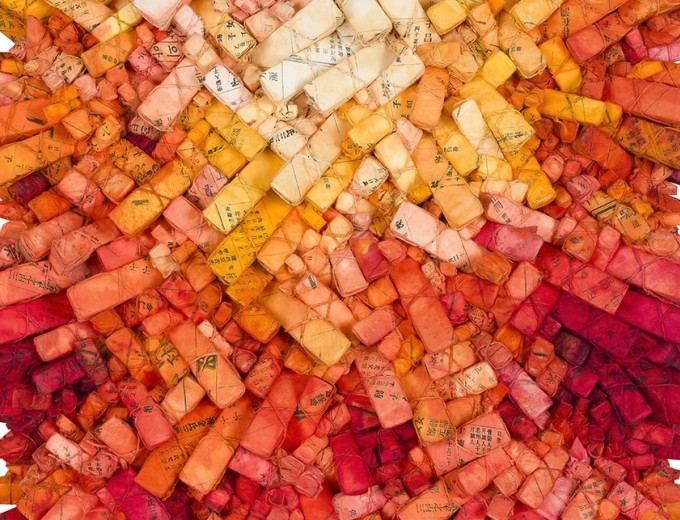
We are pleased to present the first New York show by celebrated artist Chun Kwang Young since his groundbreaking exhibition Times Reimagined at the 2022 Venice Biennale, which showcased forty of his large-scale reliefs, sculptures and installations.
Chun (b. 1944, South Korea) has garnered international acclaim for his Aggregations, a series of tactile, abstract assemblages made from thousands of triangular forms wrapped in hanji, traditional Korean mulberry paper. Chun’s intricate compositions, characterized by jagged, irregular surfaces, combine the techniques, materials and sentiment of his Korean heritage with the conceptual freedom he experienced during his Western education. For this exhibition, the artist has created a powerful body of work that suggests the next stage in the stylistic evolution of the series.
Early works in the series, often referred to as moonscapes, were primarily black and white or sepia-toned, lending them the appearance of arid deserts or lunar terrain. Chun then began to inject color into his compositions, beginning with small, contained areas of shaded indigo and vermillion nestled within subtly textured monochrome expanses. Eventually, the palette expanded to include a full spectrum of vivid color, which Chun deployed in vast, rolling gradients or patterns articulated in complementary hues. The colorful works became increasingly dimensional over time, with robustly textured surfaces resembling rocks or otherworldly crystal formations.
In this new body of work, Chun combines elements from the colorful, crystalline series with the muted, homogeneous moonscapes for the first time. He also plays with shape, introducing an organic form that stands apart from his familiar circular and rectangular wall-hung works. Anchoring the exhibition is one of the artist’s signature large-scale installations, reminiscent of the colossal sculptures featured in his Venice Biennale show.
ABOUT AGGREGATIONS
Since Chun began the Aggregations series more than thirty years ago, the use of hanji has been central to his practice. Derived from native trees and prized for its durability, hanji has been used for centuries in Korea, for everything from writing and drawing to packaging and weatherproofing. For the artist, it’s more than a material; it’s a powerful medium that embodies the essence of Korean history and imparts a spiritual power, even in its most mundane applications.
In Korea, writing is considered an art form as much as a tool of communication and there is a proud history of literary scholarship, calligraphy and book printing. With that in mind, Chun sources his paper from the pages of antique books. He prefers the superior quality of hanji made by hand, as it was before the introduction of mass-produced paper in the late-nineteenth century. The use of vintage books printed in traditional Chinese characters and Hangul, the Korean alphabet, imbues Chun’s work with a sense of memory and nostalgia, while the coalescence of different writing systems and eras transforms the text to form new meanings.
Chun describes the paper-wrapped parcels he uses to construct his Aggregations as the “minimal unit of information.” The idea for the cell-like forms was sparked by memories of medicinal herbs packaged in mulberry paper that hung from the ceiling of the local apothecary when he was a boy.
To create his compositions, he starts with the triangular forms, which are cut from block foam, then hand-wrapped in hanji and tied with string made from the same material. Each piece is adhered by hand to a flat support or sculptural substructure, then tinted with tea or pigments. The process, while labor-intensive, is meditative in its repetition.
Chun’s arrangements vary widely, crossing genres from painting to sculpture to large-scale installation. Some compositions comprise smooth, uniform surfaces while others burst from their frames. Playing with light and shadow, Chun employs subtle shifts in tone to produce the illusion of craters, dips and depressions. The overall effect, which is organic, geological, almost cosmic in appearance, gives material form to the coexistence of harmony and conflict emblematic of the human condition.
ABOUT CHUN KWANG YOUNG
Born in Hongchun, South Korea, in 1944, Chun grew up during the end of Japanese colonization and the brutality of the Korean War. In the early 1970s, he moved to the United States to pursue a master’s degree at Philadelphia College of Art, where he was deeply drawn to Abstract Expressionism. “It seemed to be the best way to freely express my surprise and sadness at witnessing the huge gap between idea and reality,” he says.
Over time, Chun became disillusioned with the materialistic drive that seemed to fuel the American dream and feelings of loneliness intensified his longing for home. During this period, Chun’s paintings, which explored the effects of light and color, reflected his interest in Abstract Expressionism, however, he ultimately found the expression inauthentic. Chun decided to return to Korea and focus on developing his own methodology, one that was wholly unique and reflective of his history and cultural identity.
Chun Kwang Young received a bachelor of fine arts degree from Hongik University, Seoul, and a master of fine arts from the Philadelphia College of Art, Pennsylvania. He first showed at the Venice Biennale in the group exhibition Frontiers Reimagined, held at the Museo di Palazzo Grimani in 2015. He returned to Venice in 2023 in Times Reimagined, an exhibition organized with support from the Boghossian Foundation and the Museum Ground, mounted at the Palazzo Contarini Polignac.
Chun’s work is in numerous public collections, including The British Museum and Victoria & Albert Museum, London; The Rockefeller Foundation and United Nations, New York; Woodrow Wilson International Center for Scholars, Washington, DC; Philadelphia Society Building, Pennsylvania; National Museum of Modern and Contemporary Art, Seoul, and Seoul Museum of Art; National Gallery of Australia, Canberra; and National Museum of Fine Arts, Malta.

